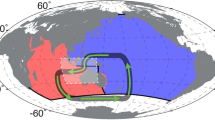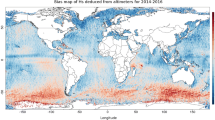Abstract
Zonal advection by long equatorial waves has been shown to be an important process in the evolution of sea surface temperature in the central Pacific on ENSO time scales. The present study aims at investigating how well an oceanic model whose dynamics are based on long equatorial waves can simulate the large-scale surface zonal current variability. Thus an ocean linear model which can be run with two or three layers is validated against several sets of observations in the Pacific ocean (TOPEX/POSEIDON sea level, TAO zonal currents, surface current climatology). The surface layer (mixed-layer) has a constant depth. Therefore the layer model is equivalent to considering a shear layer solution and either one or two baroclinic modes. It allows evaluation of the impact of adding a second baroclinic mode on the simulation of surface currents. This evaluation is done for different friction parametrizations: a weak linear Rayleigh friction (24 months−1), a strong linear Rayleigh friction (6 months−1), and a new parametrization using quadratic friction in the momentum equation only. It is shown in all simulations using various Rayleigh friction parametrizations that the addition of a second baroclinic mode always improves the simulation of both the sea level and the surface currents, especially in the central western Pacific. In that region, there is a reduction of the propagating long Rossby waves whose amplitude is much too large when only one baroclinic mode is used. Despite this reduction, the use of a weak friction (24 months−1) always yields results which compare only poorly to observations confirming results from previous studies. The use of strong friction (6 months−1) improves the model simulation, but surface current variability still remains too large. Finally, the use of quadratic friction as proposed in the present study considerably improves the simulation of zonal currents and its comparison to all data sets. This result gives more confidence in the choice of such a simple model to further explore the role of zonal advection by long equatorial waves on ENSO time scales.
Similar content being viewed by others
Author information
Authors and Affiliations
Additional information
Received: 28 May 1999 / Accepted: 18 May 2000
Rights and permissions
About this article
Cite this article
Boulanger, JP. The Trident Pacific model. Part 1: simulating surface ocean currents with a linear model during the 1993–1998 TOPEX/POSEIDON period. Climate Dynamics 17, 159–173 (2001). https://doi.org/10.1007/s003820000100
Issue Date:
DOI: https://doi.org/10.1007/s003820000100




